
How long does it take for muscle growth to plateau?
According to this 2017 review study out of the USA, it plateaus quicker than you think.
Based on an array of experiments examining the time course of muscle growth, the authors make some bold statements.
Regarding the lower body muscles, they say “these studies support the hypothesis that a large percentage of an individual’s muscle growth potential will likely be achieved within the first 3 months of training.”
They go on to say “it seems unlikely that individuals will increase their muscle mass by appreciable amounts beyond what is gained by the time of plateau”
Regarding the upper body, they say “initial statistical change in muscle size from baseline often occurred prior to weeks 4-6 of training, with a plateau 3-4 weeks after this initial response.
They go on to say “it can be expected that muscle growth is unlikely to meaningfully increase further in a TRAINED population”
Many would agree these statements seem extraordinarily surprising and perhaps controversial.
In this article, we’re going to examine the research behind these statements. With the aim of answering the question: “does muscle growth plateau far quicker than we think?”
Let’s get into it.
Table of Contents
Part I: Muscle Growth Plateaus FAST
Let’s detail some of the research that led the authors of that review study to make the statements they did.
First, we have this 1999 study out of Japan, which had 37 untrained individuals perform these following exericses: leg extensions, leg curls, chest press, triceps extensions, biceps curls, and seated rows.
Each exericse was trained for 1-3 sets, with 8-12 repetitions performed to failure, three times per week for 12 weeks.
Both the men and women of the study saw a significant drop off in quadriceps development by the 8th week of training.

Furthermore, the men in the study tended to plateau in biceps and triceps growth by week 8.

While the women in the study also tended to see a triceps growth plateau by the 8th week.

A 2011 study out of the USA had untrained men train the leg press and leg extension each for 3 sets of 8-12 repetitions to failure, three times per week for 8 weeks, and established thigh growth tended to level off after 6 weeks of training.
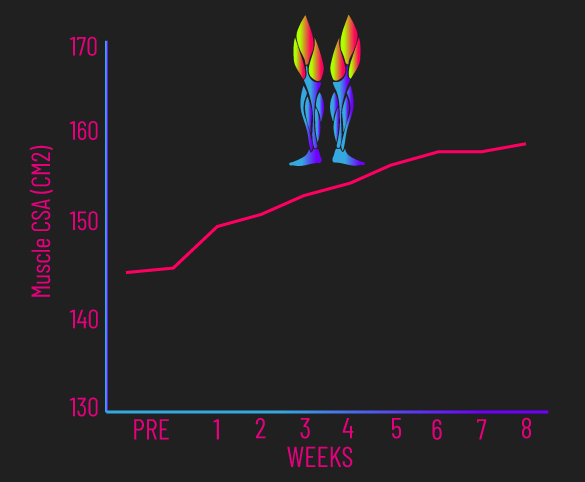
A 2013 study out of Brazil had subjects train eccentric leg extensions for 3-5 sets of 10 repetitions, twice per week for 10 weeks, and found rectus femoris growth tended to level off at the 8-week mark.
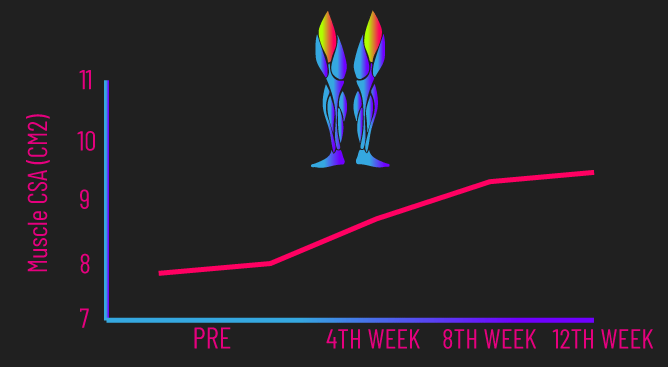
A 2015 study out of England had subjects train leg extensions for 6 sets of 8 repetitions with a 75% one-rep max load, three times per week for 6 weeks, and found the vastus lateralis grew well from week 0 to week 3, but did not really grow much further from week 3 to 6.

Now, progressive overload was applied in all these studies, so a lack of progressive overload cannot explain the plateaus.
Part II: Studies Showing Sustained Long-Term Gains?
The studies just overviewed are highly interesting and collectively support the authors’ conclusions that muscle hypertrophy shows signs of plateauing and dropping off within 3 months.
Yet, are there studies opposing this?
There are.
A study out of Japan all the way back from 1970 had untrained men trian maximal isometric biceps contractions for 10 seconds, repeated 3 times per session, for 6 days a week, and found muscle growth did not show signs of plateauing across 100 days.

Another 1996 study out of Switzerland had untrined men train leg extensions for 6 sets of 8 repetitions with an 80% one-rep max load, every other day for 6 months, quadriceps growth continued to increase consistently across the 6 months of training.
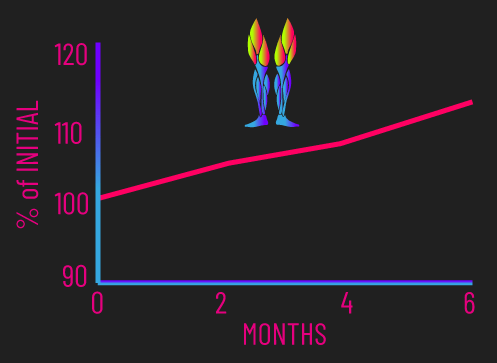
In addition to this, we have numerous studies finding trained individuals experience notable muscle growth in response to training.
This 2019 study out of Brazil recruited 20 trained men with an average 94kg bench press, and an average 125kg back squat.
One group trained their muscles once a week, while another twice a week (programs shown below). The number of exercise sets performed each week was the same between groups.
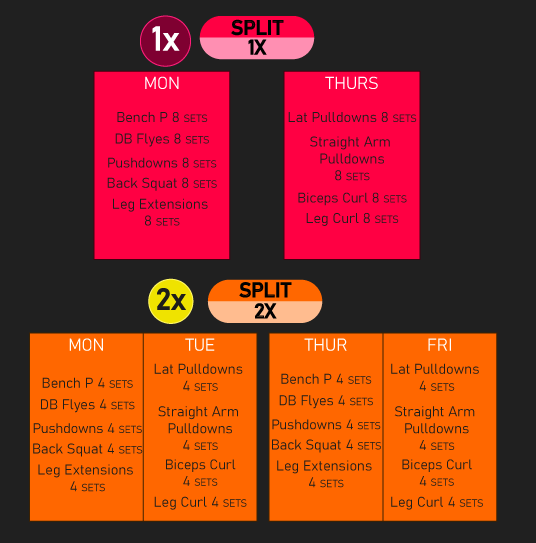
Ultimately, both groups saw comparable and notable increases in triceps, biceps, vastus lateralis, and anterior quadriceps growth.

The percentage gains ranged from 5-11% in thickness, which is still notable, and nontrivial gains.
A 2015 study out of New York recruited 18 men with an average bench press of around 101kg and back squat of 121kg.
Subjects trained the back squat, bench press, seated row, overhead press, lat pulldown, leg press, and leg extension exercises for 3 sets per session, thrice per week for 8 weeks.
One group trained with 8-12 reps to failure per set, and a second group with 25-35 reps to failure.
Ultimately, both groups saw comparable and notable increases in biceps, triceps, and quadriceps femoris growth. The percentages ranged from 5-9% in thickness.
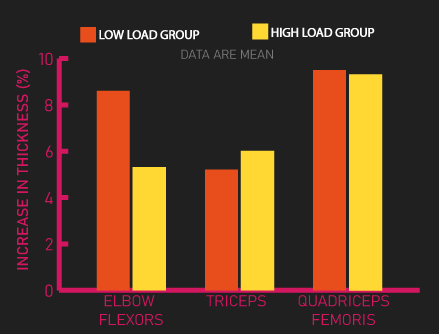
Another 2016 study out of New York recruited 13 men with an average 93kg bench press and an average 118kg back squat.
Subjects trained the back squat, bench press, seated row, overhead press, lat pulldown, leg press, and leg extension exercises for 3 sets of 8-12 reps to failure per session, thrice per week for 8 weeks.
One group rested 3 minutes between sets, a second group rested 1 minute between sets.
Ultimately, both groups saw gains in the biceps, triceps, anterior quadriceps, and vastus lateralis, but the gains were greater for the group resting for 3 minutes.

This finding is consistent with the rest of the literature, with compound exercises specifically (compound exercises were mainly trained in this study), 2.5-3 minutes of rest tends to produce greater muscle growth versus shorter rest durations.
This finding emphasizes how optimizing variables can meaningfully promote greater growth in trained individuals.
Another notable variable is individualizing your exercise selection.
Not everyone has the same anatomy and preferences, and this can matter for muscle growth. We covered this in a previous article, but it’s worth briefly overviewing this interesting study again.
17 men who back squatted an average 140kg and bench pressed an average 110kg were recruited.
Subjects were assigned to a fixed or autoregulated group.
The fixed group was given this program to train weekly.
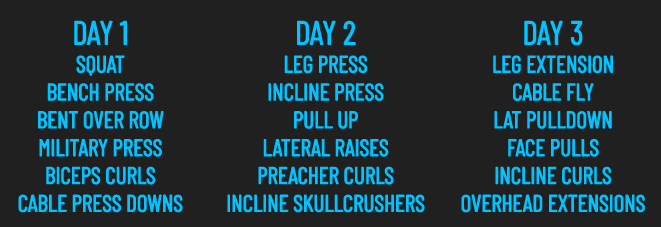
The autoregulated group was free to select what exercises they wanted to train per muscle group each session from a wide list.
All other training variables were the same between groups.
By the end of the 9-week study duration, lean body mass gains were greater for the autoregulated group.
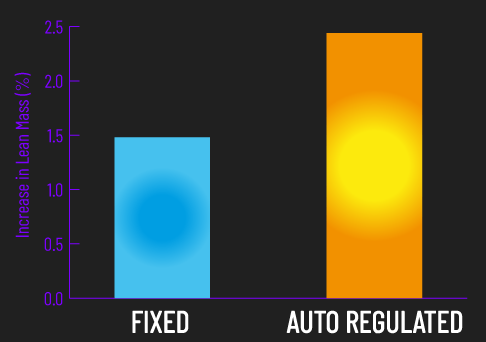
Presumably, at least some of this result is due to trained individuals having a good understanding of what exercises work best for them, leading to better muscle adaptations.
So individualizing your exercise selection can be important.
All of these studies oppose the notion that trained individuals cannot experience much further muscle growth.
Before moving on, if you’re curious about creating an effective training program for muscle hypertrophy, our high quality partner Alpha Progression can help. It can generate a highly effective program for you, track your workouts live with in-built progression recommendations, provide graphs displaying your long term progress, and it has a massive exercise database with more than 550 exercises.
Click HERE (the link opens in a new tab) to get a free 2 week trial of the apps features. If you like it and go beyond, the link also gives you 20% off a subscription!
We never promote trash at the House of Hypertrophy, so rest assured the app is high quality. The reviews speak to this, 4.8 starts (based on more than 7,000 reviews) on Google play, and 4.9 stars in Apple’s store (based on nearly 400 ratings).
Part III: Limitations With the Data
Returning back to the studies observing signs of plateauing within 3 months, they had notable limitations.
None of them mentioned factors away, such as nutrition.
Nutrition Discussion
Given the subjects were previously untrained and given no nutritional instructions, it’s reasonable to assume many were not eating optimally for muscle hypertrophy.
This matters as both caloric and protein intake have been shown to modulate the amount of muscle growth you experience.
A 2002 study out of the USA had previously untrained men weight train for 8 weeks, and found subjects consuming around a 2,000 calorie surplus gained around 3kg in body mass and virtually all of this was fat-free mass. Another group eating at approximately calorie maintenance saw much lower changes in body and fat-free mass.
A 2019 study out of Brazil found in competitive bodybuilders, higher calorie consumption (around 6,500 calories) produced greater muscle mass gains versus a lower calorie consumption (around 4,500 calories).
This review study summarizes (shown below) calorie surplus recommendations for untrained and trained folks.
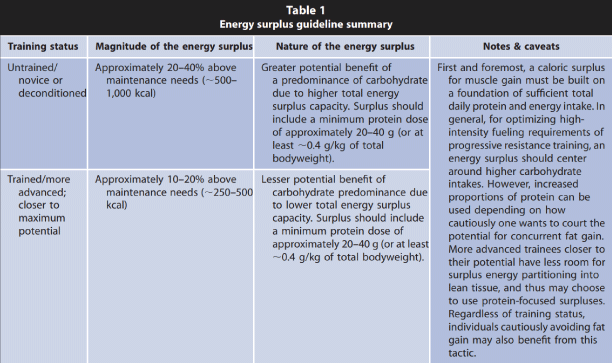
Protein intake is also notable. This 2018 meta-analysis out of Canada observed on the basis of 49 studies, that intakes up to 1.6 grams of protein per kg of bodyweight enhanced fat-free mass gains.
Furthermore, we actually have data demonstrating even in the absence of a caloric surplus, trained individuals are still able to see good increases in lean muscle mass, provided protein intake is sufficient.
A 2006 study out of Australia recruited trained men who bench pressed an average 84kg and back squatted an average 80kg. In other words, they skipped leg day.
Subjects trained the program below for 10 weeks.
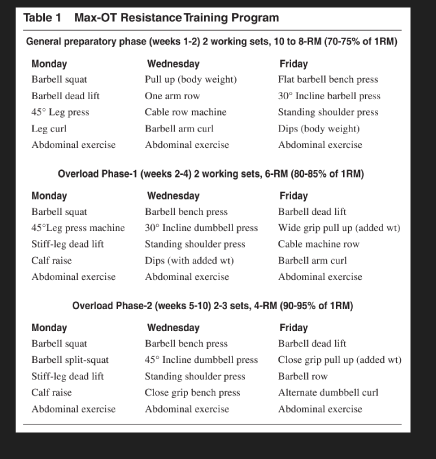
Subjects did not increase their calories versus before the study (and were likely not in a surplus). One group of subjects supplemented with whey protein, while another group supplemented with casein.
Both groups ultimately consumed around 2 to 2.2 grams of protein by kg of bodyweight daily.
The whey supplement group saw a concurrent increase in lean mass with decreases in fat mass, while the casein group saw smaller increases in lean mass with little change in fat mass.
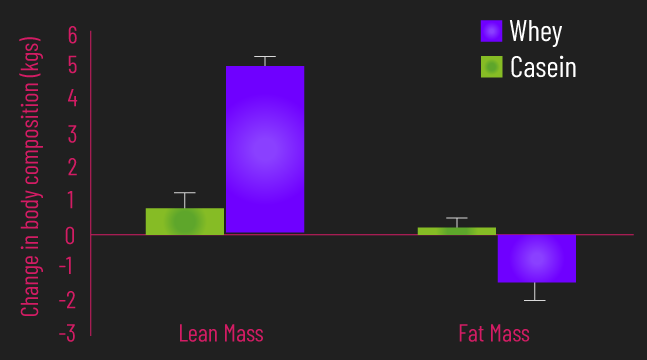
This study seemingly indicates whey protein is superior to casein, yet I should note another study found both to be similar. Thus, the differences in this study could just be related to the small sample sizes.
In any event, I mention this data to demonstrate that trained individuals can still experience a good increase in lean mass with little changes or even decreases in fat mass.
A 2015 study out of the USA recruited 32 trained men who squatted 120kg, benched 102kg, and deadlifted 158kg. These subjects didn’t seem to skip leg day.
Subjects trained the program below for 4 weeks, with one group supplementing some mixed ingredient supplement, and another group taking a placebo.
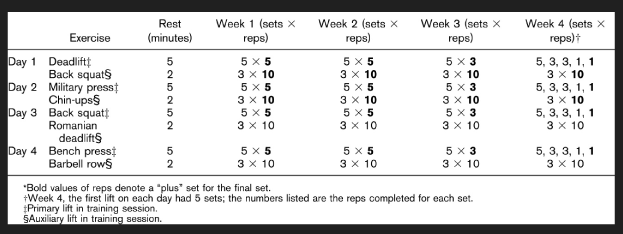
Unfortunately, calorie and protein intakes were not mentioned, but both the supplement and placebo groups saw increases in lean mass with little changes in fat mass ( the placebo group actually tended to lose fat).
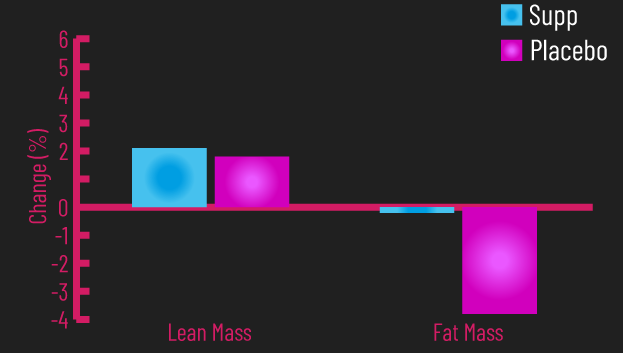
So again, this study demonstrates that trained individuals can see good increases in lean mass with little changes or decreases in fat mass.
A 2018 study out of the USA recruited 28 trained men who squatted 138kg, benched 103kg, and deadlifted 163kg.
All subjects performed the same number of sets per week on their exercises, but one group trained their exercises with a frequency of three times per week, while another group trained their exercises with a frequency of six times per week.

Calorie and protein intakes were unfortunately not mentioned, but both groups similarly increased fat-free mass (the greater gains for the 6x group were non significant), while fat decreased in the 3x group with minimal changes in the 6x group.

Finally, a 2019 study out of Brazil recruited 23 trained men who bench pressed 103kg and squatted 132kg.
One group trained with a bro-split style routine, while another group trained with a full body routine. The number of sets performed on each exercise per week was the same between groups.

Subjects were consuming what appeared to be maintenance calories, and they consumed around 1.9 grams of protein per kg of body weight daily.
Ultimately, both groups similarly increased lean mass.
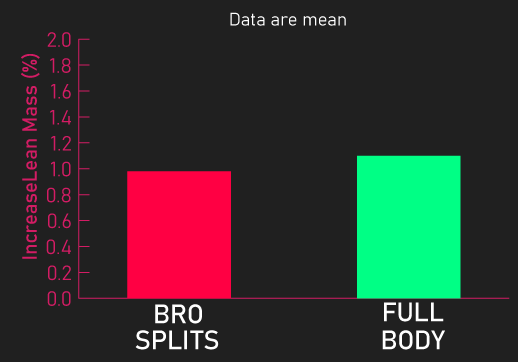
Fat mass was not mentioned, but given subjects were eating around maintenance, fat mass gains are unlikely.
So, these studies collectively demonstrate that trained individuals are capable of increasing lean mass with little to no fat changes, provided protein intake is sufficient.
Moreover, as alluded to by some of the data, body recomposition (that is, increasing muscle while losing fat) is also possible in trained individuals.
There’s ample literature indicating body recomposition can occur in trained individuals.
To set this up, you may do the following:
Firstly, a caloric deficit is your surest bet to ensure fat loss, but too much of a deficit will impair lean mass gains. A recent 2021 meta-analysis indicates a 500 calorie deficit may be the point where lean mass gains cease when resistance training, so a deficit smaller than 500 calories is recommended.
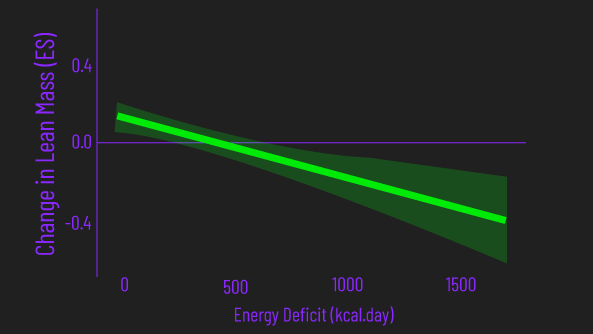
Secondly, ensuring adequate protein intake, in the range of 1.6 to 2.2 grams per kg of body weight is likely required.
Of course, the more and more trained you get, the more difficult it is to attain body recomposition.
But so long as you’re not super advanced and really close to your genetic ceiling, the literature overviewed convincingly demonstrates that trained individuals can see gains in muscle mass with little change or decreases in fat mass.
As an additional point, recall that the review study mentioned at the start of the atiocle indicated trained individuals are unlikely to see further appreciable gains. Yet all the data we’ve outlined in this section further strongly oppose this, the trained individuals saw appreciable adaptations.
Training Variables Discussion
Moving foward, nother limitation of the studies demonstrating muscle growth plateaus within 3 months is that there was minimal variation in the training variables used.
Except for the fact progressive overload was applied, all other variables (including exercise selection, volume, and rep ranges) were maintained.
Exercise selection is potentially a notable one. All the studies had subjects train their muscle group with largely only one exercise.
It’s possible training a muscle group with a few different exercises in a program is beneficial for sustaining long-term gains, but more research is needed to verify this.
At the very least though, performing a few different exercises per muscle group in a program does tend to grow more regions across that muscle.
Demonstrating this is a 2021 study out of Brazil.
A non-varied group performed the same exercises for their muscles across 3 sessions per week.
A varied group, on each of the three days per week, performed different exercises per muscle group.

Before and after 8 weeks of training, growth of the upper, middle, and lower regions of the rectus femoris, vastus lateralis, elbow flexors, and triceps was measured.
Overall, though growth in some regions was similar, the varied group saw more gains in other regions. Thus, exercise variety can cause growth in more regions of a muscle.

With regards to rep ranges, training with a single rep range potentially could be suboptimal for hypertrophy.
Now, most studies lasting 12 weeks or less find muscle growth to be similar between training with a single rep range or using a mix of different rep ranges.
But one study with a 9-month duration recruited previously untrained women, with one group using the same rep range across 3 sessions per week, and another group varying their rep ranges across 3 sessions per week.
Ultimately, increases in fat-free mass were greater for the group varying their rep ranges.

Now, I should mention this is a single study, and more data is needed to verify whether varying rep ranges truly promote greater muscle growth in the long term.
Volume (in the form of sets performed) is also a notable factor. There’s emerging research suggesting in trained individuals, modestly increasing the number of sets performed enhances muscle growth.
For example, a study from USA had trained men (who back squatted an average 165kg) train their quadriceps with a variety of weekly set numbers.
Fundamentally, their results established that those who grew their anterior thigh the most were the individuals who performed an average 6 more weekly sets for the quadriceps compared to what they were performing before the study.
Lower responders (that’s individuals who grew their anterior thigh less) only performed 1-4 more weekly sets for the quadriceps compared to what they were doing before the study.
Another 2022 study out of Brazil recruited trained men and had them train the unilateral leg extension and unilateral leg press twice per week for 8 weeks.
With one leg, each subject individually performed 20% more weekly sets for their quadriceps than what they were doing before the study.
With their other leg, all subjects performed the prescribed number of weekly sets for the quadriceps, this was 22 weekly sets.
It was found vastus lateralis growth was greater for the leg performing 20% more weekly sets.

So a progressive increase in weekly sets (20%) seems to be beneficial for muscle growth.
An interesting point is for 8 out of the 16 subjects, the prescribed number of 22 weekly sets was actually more than 20% of the weekly sets they’d performed for their quadriceps before the study. It ranged from being 30% to 120% more weekly sets than usual for these subjects.
Yet, results still favored the leg that performed 20% more weekly sets.
This finding emphasizes that larger jumps in weekly sets (30-120%) are not necessarily better than more modest (20%) increases in weekly sets for muscle hypertrophy.
Therefore, these two studies suggest modestly increasing the number of sets you perform may be an extremely effective way to get past plateaus.
Part IV: Potential Use of Training Breaks
All of the studies finding signs of plateaus understandably had subjects train week after week.
Yet, as we’ve explored in a previous article, there’s some research suggesting training breaks may be effective for restoring responsitivity to training and perhaps enhancing long-term muscle and strength gains.
For example, this study from Japan had men train the barbell bench press with these training variables. One group trained for 24 weights straight (a continuous group), while another trained for 6 weeks, rested for 3 weeks, and repeated this for a total 24 weeks (a periodic group).
Ultimately, growth of the triceps and pectoralis major as well as bench press one-rep max strength gains ended up being similar between both groups.

This was possible because the continuous group rate of gains gradually slowed down (in other words, they were nearing a plateau), whereas the periodic group, despite losing muscle and strength during the 3-week breaks, gained muscle and strength at faster rates during their training weeks.
The training breaks taken by the periodic group may have resensitized their body, thereby explaining their faster rate of muscle and strength gains during the training weeks.
For more details on training breaks, check out the full research breakdown we did on it.
But I should mention more research is needed to truly establish the effectiveness of training breaks, but the current research is promising and an individual may wish to experiment with it depending on their interpretations of the data as well as their feelings on it.
Part V: Summary
In summary, we do have research showing muscle growth may show signs of plateauing within 3 months of training.
Yet, these studies have limitations. Nutrition factors such as calorie and protein intakes were likely not optimized. Also, static training variables were used, something that might not be conducive towards long-term muscle growth.
Moreover, recall there exists opposing data. There are studies finding muscle growth shows no plateau signs within 3 months. There are also lots of data finding well trained individuals still experience notable muscle growth in response to training.
Due to everything we’ve overviewed in this article, needless to say, I don’t agree with the conclusions of the review study mentioned at the start of the article.
With a well-designed training program and lifestyle, I think it’s very likely individuals can see appreciable muscle development across numerous years. Moreover, we see this in the real world, individuals can see notable improvements despite having numerous years of prior experience.
Remember to feel free to check out the Alpha Progression App if you’re interested. Also feel free to check our free bench press e-book below.

